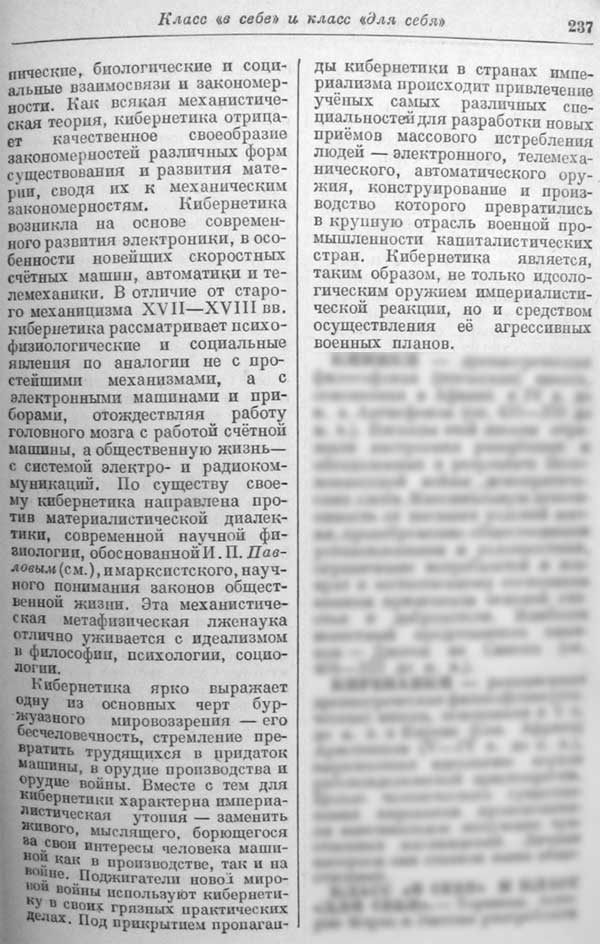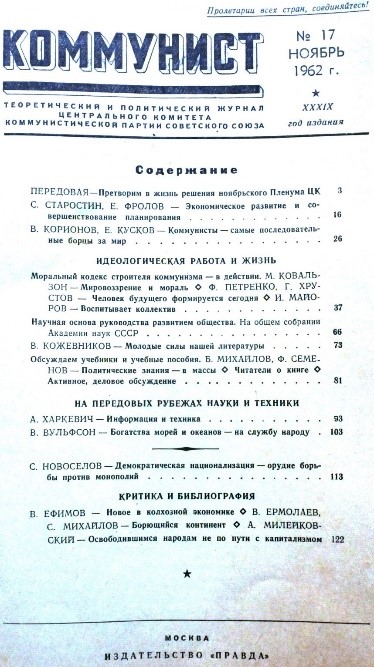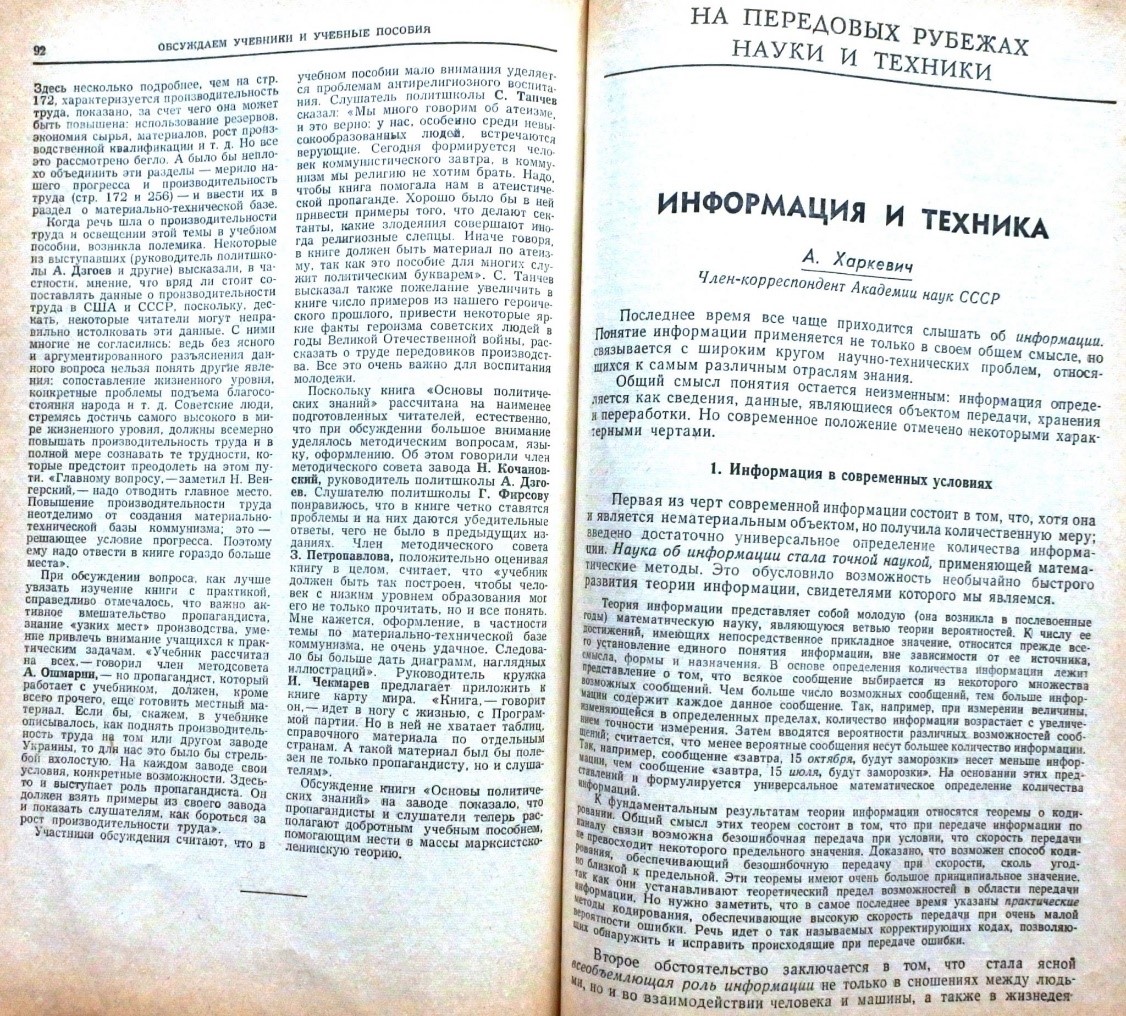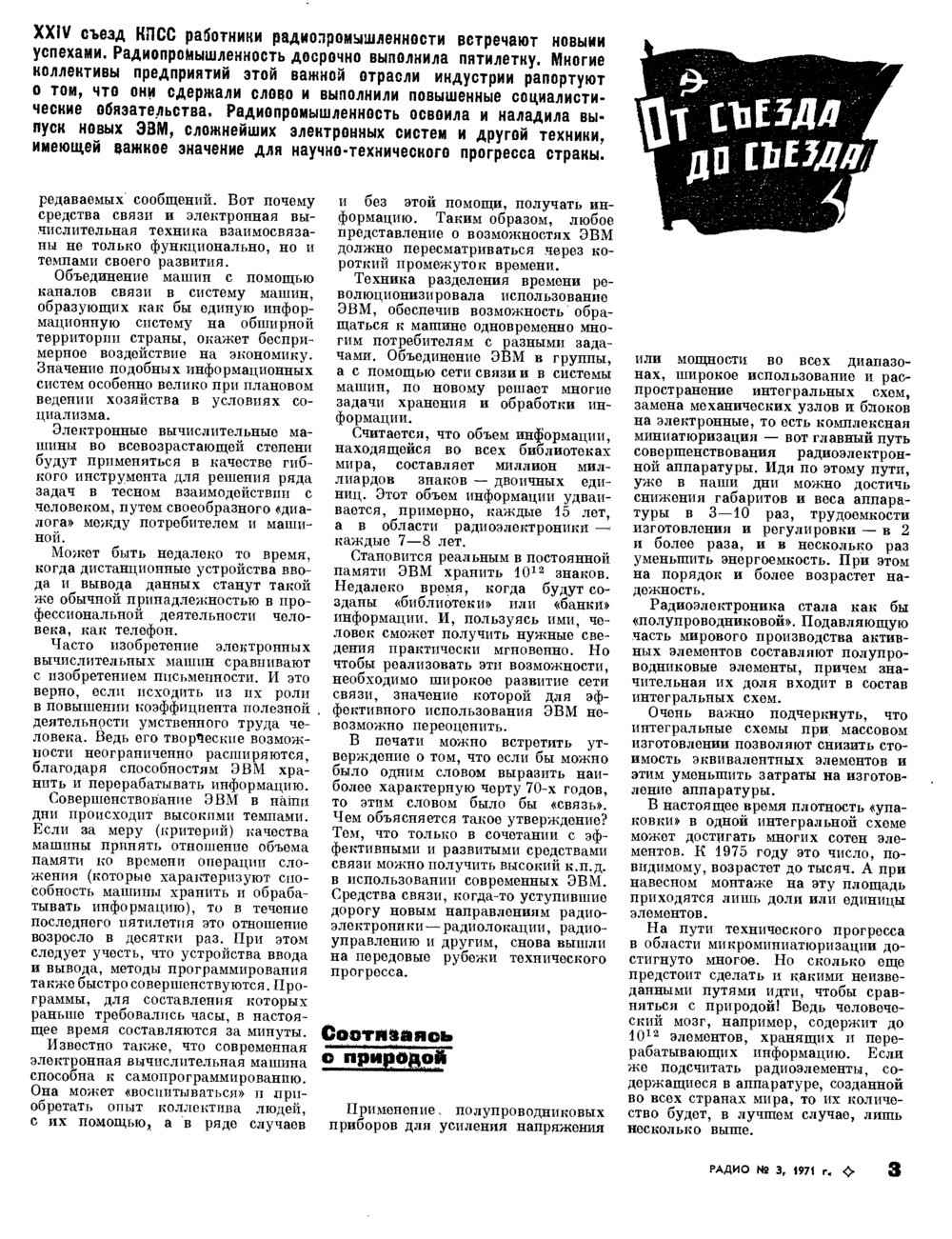Cybernetics in the USSR: from pseudoscience to a panacea
Many scientific broadcasts, books and journalistic investigations were created in the field of "computerization" of the USSR. Some say that computers in the country appeared under the influence of the West. Others - that the Soviet Union was following its own torrid path.Today's article is a small study of the history of the development of cybernetics in the USSR. Under the cut, we tried to collect as many views as possible on the construction of "cyber communism." We give the floor to those who directly participated in the development of projects, and those who took advantage of the benefits of computerization.Go!
– – « »…
, , , .
, « ». .
The article may seem far-fetched and even caustic to you. We dare to assure you: the situation is quite the opposite. First of all, we would like to find a “middle ground” in our view of events that began back in the 1950s.Among other things, the video “Step into Cyber Communism: Computers and Planning in the USSR” inspired us to write the article . Nevertheless, Alexei Safronov, the author of the lecture and the candidate of economic sciences, had the goal of telling about the computerization of the USSR from a purely economic point of view. We, in turn, would like to concentrate on the “human” side of the issue.To avoid a conflict of generations, interests and views, we will build the story on the following points:- , « », . , , , .
- . - . , , , . , , «» - . : .
- After decades, many events were distorted in the memory of people under the influence of the interests of individuals, one way or another connected with these events.
- Due to the chaos that reigned in the early years of computer life (not only in the USSR, but also in the world), it is almost impossible to reach all the actors and tell about all the subtleties of the design of these very computers. Among other things, if the scientific publications, diaries and popular works of many Soviet scientists were digitized and not stored in paper form on library shelves, we would be able to collect more documentary evidence about the era of cybernetics. If you have interesting additions, please share them in the comments.
Cybernetic state
To better understand the motivation of Soviet scientists, we give the definition of cybernetics from Wikipedia. In our opinion, it was built very successfully:Cybernetics is the science of the general laws governing the receipt, storage, transformation and transmission of information in complex control systems, whether it be machines, living organisms or society.
Nevertheless, until the beginning of the 1950s, cybernetics in the USSR was considered "bourgeois pseudoscience." At the beginning of 1950, Anatoly Kitov, the colonel and one of the pioneers of Cybernetics, received the opportunity to get acquainted with the book of the outstanding American mathematician Norbert Wiener «Cybernetics» , which determined his whole future work. For several years, Kitov, Lyapunov and the few "associates of cybernetics" have sought at least the first publication of their fundamental article, "The Basic Features of Cybernetics."
 Excerpt from the Brief Philosophical Dictionary of the USSR, fotoru.infoBy the mid-1950s A.I. Kitov headed the same created computer center under the Ministry of Defense of the USSR and proposed the creation of a nationwide automated control system based on the USSVC (Unified State Network of Computer Centers). In particular, he noted a significant lag behind the United States in the field of computer production. The very first works of Kitov in the field of control automation based on the use of computers date back to 1956: then his book "Electronic Digital Machines", the first domestic "textbook" on computers and programming, accessible to the general reader, was published. This work made a lot of noise in the scientific community and actually made a revolution in understanding the capabilities of computers.In the work "Electronic Computers", which was published in 1956, Kitov outlined in detail the prospects for the integrated automation of information work and administrative management processes, including production management and solving economic problems.Under the direction of A. I. Kitov, in 1958, one of the most powerful tube computers in the world “M-100” was developed at that time, producing 100,000 operations per second.In 1959, a joint resolution was adopted by the Central Committee of the CPSU and the Council of Ministers of the USSR on the accelerated creation of new computers. Nevertheless, Kitov’s idea of creating a unified network of support from the state did not receive.The next, more detailed Kitov’s project was called the Red Book. It described the creation of an all-Union network of dual-use centers: to manage the economy in peacetime and the armed forces in “special periods”.Nevertheless, criticism of the state of affairs at the USSR Ministry of Defense ensured a sharply negative attitude to his ideas from the leadership of the Moscow Region and the workers of the Central Committee of the CPSU, which ultimately led to the exclusion of Kitov from the party and his removal from his post.Here, perhaps, we should be critical of such a decision of the top leadership: Kitov clearly understood how to change the approach not only to peaceful, but also to military tasks by progressive methods. Kitov’s biography allows him to judge his competence: in 1941, with the rank of junior lieutenant, Kitov was drafted to the front, and ended the war in Germany in 1945, after which he was admitted to the Department of Jet Weapons of the Artillery Academy named after F.E. Dzerzhinsky, who graduated with honors in 1950.But if you look at the decision to remove Kitov from the Central Committee of the CPSU, it is not difficult to calculate the motivation of party workers: a progressive scientist proposes to build a completely monstrous system, the implementation of which will require enormous financial resources, and the result will not appear too soon. They can fly their heads.A number of interesting additions to this topic that are not included in this article can be found in the article by S. B. Ogajanyan .Nevertheless, the idea proposed by Kitov was not forgotten and rejected at all. According to the CPSU program, approved in 1961, cybernetics was to become one of the main means of development of the country. It was planned to use computers in almost all industries, in construction, in research and planning. If at the beginning only a small group of scientists was engaged in cybernetics, then by the end of the 1960s, research in the field of cybernetics was carried out by more than 500 institutes. Without a doubt, the question of automating manual labor and, accordingly, increasing the efficiency of not just organizations, but the whole state was very acute and was actively supported by the USSR government.In order not to be unfounded, we give below quotes from Axel Ivanovich Berg, one of the founders of the school of biological cybernetics in the USSR and the chairman of the scientific council on the issue of "Cybernetics" under the Presidium of the USSR Academy of Sciences.
Excerpt from the Brief Philosophical Dictionary of the USSR, fotoru.infoBy the mid-1950s A.I. Kitov headed the same created computer center under the Ministry of Defense of the USSR and proposed the creation of a nationwide automated control system based on the USSVC (Unified State Network of Computer Centers). In particular, he noted a significant lag behind the United States in the field of computer production. The very first works of Kitov in the field of control automation based on the use of computers date back to 1956: then his book "Electronic Digital Machines", the first domestic "textbook" on computers and programming, accessible to the general reader, was published. This work made a lot of noise in the scientific community and actually made a revolution in understanding the capabilities of computers.In the work "Electronic Computers", which was published in 1956, Kitov outlined in detail the prospects for the integrated automation of information work and administrative management processes, including production management and solving economic problems.Under the direction of A. I. Kitov, in 1958, one of the most powerful tube computers in the world “M-100” was developed at that time, producing 100,000 operations per second.In 1959, a joint resolution was adopted by the Central Committee of the CPSU and the Council of Ministers of the USSR on the accelerated creation of new computers. Nevertheless, Kitov’s idea of creating a unified network of support from the state did not receive.The next, more detailed Kitov’s project was called the Red Book. It described the creation of an all-Union network of dual-use centers: to manage the economy in peacetime and the armed forces in “special periods”.Nevertheless, criticism of the state of affairs at the USSR Ministry of Defense ensured a sharply negative attitude to his ideas from the leadership of the Moscow Region and the workers of the Central Committee of the CPSU, which ultimately led to the exclusion of Kitov from the party and his removal from his post.Here, perhaps, we should be critical of such a decision of the top leadership: Kitov clearly understood how to change the approach not only to peaceful, but also to military tasks by progressive methods. Kitov’s biography allows him to judge his competence: in 1941, with the rank of junior lieutenant, Kitov was drafted to the front, and ended the war in Germany in 1945, after which he was admitted to the Department of Jet Weapons of the Artillery Academy named after F.E. Dzerzhinsky, who graduated with honors in 1950.But if you look at the decision to remove Kitov from the Central Committee of the CPSU, it is not difficult to calculate the motivation of party workers: a progressive scientist proposes to build a completely monstrous system, the implementation of which will require enormous financial resources, and the result will not appear too soon. They can fly their heads.A number of interesting additions to this topic that are not included in this article can be found in the article by S. B. Ogajanyan .Nevertheless, the idea proposed by Kitov was not forgotten and rejected at all. According to the CPSU program, approved in 1961, cybernetics was to become one of the main means of development of the country. It was planned to use computers in almost all industries, in construction, in research and planning. If at the beginning only a small group of scientists was engaged in cybernetics, then by the end of the 1960s, research in the field of cybernetics was carried out by more than 500 institutes. Without a doubt, the question of automating manual labor and, accordingly, increasing the efficiency of not just organizations, but the whole state was very acute and was actively supported by the USSR government.In order not to be unfounded, we give below quotes from Axel Ivanovich Berg, one of the founders of the school of biological cybernetics in the USSR and the chairman of the scientific council on the issue of "Cybernetics" under the Presidium of the USSR Academy of Sciences.In all cases when a process is developing and it is necessary to control it to achieve a specific goal at a given time, people use the methods that have been called cybernetic, following Ampere, in recent years. Thus, cybernetics can be called the science of purposeful management of developing processes.
A. I. Berg, report at a meeting of the Presidium of the USSR Academy of Sciences on April 10, 1959
, , … <…> , , , , . <…> , , , .
.. , , 23 1959 .
To build the very first networks, it was planned to use computers and communications already existing in the country. In particular, it was proposed to use the resources and channels of the air defense and missile defense systems to organize the centralized collection and processing of statistical data.Nevertheless, speaking of an arbitrarily significant event in the history of the USSR, one cannot ignore the parallel studies of the United States, about which Soviet scientists and politicians were aware.In a previous article, we already talked about how the United States in those same years worked to create its own network that is resistant to damage to individual sections. In particular, it was then that packet switching technology was formed and implemented.A prominent Soviet scientist Alexander Kharkevich in 1962 published an article in the journal "Communist" on the role of information in modern society. In order not to quote in the form of an indirect speech, we are sharing with you the text of the article in djvu format (link to download the archive of 7 MB, the article is on page 496) and several photos of the same issue of the journal.

 Images taken from streetmarket.ruIn particular, in the article, in addition to a very progressive look at the methods of transmission, storage and processing of information, there is a section describing the idea of ECC, a unified communication system:
Images taken from streetmarket.ruIn particular, in the article, in addition to a very progressive look at the methods of transmission, storage and processing of information, there is a section describing the idea of ECC, a unified communication system:Railways The USSR forms a railway network that is uniform in organizational and technical relations. <...> The idea naturally arises of the need to build a single state-wide information transfer system that provides all the needs of the country ... <...> In the country, of course, there is already a communication system, and, moreover, a very extensive one. But this system in the future (and partly already now) cannot satisfy us. <...> ... it is not geographically full ... <...> ... the capacity in the main directions is insufficient. <...> ... the existing network has neither organizational, nor technical unity .
In the same article, Harkevich writes about well-known US developments in the USSR:, , . . , , «» (), ; , , .. <…> , .
Nevertheless, it will be completely wrong to talk about the emergence of the "Soviet Internet" even at the level of ideas. The computers that existed in the USSR in those years could only be called personal computers with a huge stretch. Unless in a situation where only one person interacted with a computer at a time, and not a dozen specialists. Rather, they resembled grandiose programmable calculators, the main task of which was to make specific calculations. And the Internet "for people" of them was impossible to build, and was not planned.Literally in the same month, Alexei Kosygin met with the director of the Kiev Institute of Cybernetics Viktor Glushkov, during which Glushkov proposed a plan to create a network that unites many of the largest data centers in large cities, to which several thousand smaller cities will be connected. The main task of the new project, called OGAS (National Automated System for Accounting and Processing Information), as you might guess, was a centralized collection of data from all industries and departments of the USSR. Kitov’s original idea was rethought by Glushkov (according to some sources, Glushkov’s idea came up on his own) and finally found a response from senior management.Briefly about ACS and OGAS
In the mid-60s, the country began the mass introduction of industrial control systems, which in the future will lead to the creation of a separate control system. Victor Glushkov, who had strong friendly relations with Kitov, continued his undertaking, but acted much more diplomatically. In addition, the events that we wrote about above, collectively created fertile soil for his work.In each industrial sector, the state organized the leading research institutes for the creation and implementation of ACS, where the Council of Chief Designers of ACS also acted.Here is what V. Glushkov writes about the stages of creating the OGAS:: , - , ( ). . -, , . — , - . , . , . - ( ) , .
V. Glushkov, Macroeconomic Models and Principles of Building the OGAS
We also recommend that you familiarize yourself with the book by G. Maksimovich “Conversations with Academician V. Glushkov” . It was written quite popularly, but even a cursory reading will allow one to form an opinion about the development of computers in the USSR and the then existing views on the future of cybernetics and information processing methods. In order not to repeat the already well-known history of the OGAS, which was never fully realized, and not to copy the contents of the video mentioned at the beginning in the text, we recommend that you familiarize yourself with it. As we have already said, the author carried out extraordinary work to analyze the development of the Soviet computer network, introducing some adjustments into the history known to a wide circle. In particular, the events of 1965-1985 are interesting, that is, the period of work on the OGAS and ASPR, as well as a more in-depth analysis of the historical “tandem” of the Kitov-Glushkov.In the mid-late 1980s after the death of the chief ideologist of the OGAS and cyber communism V. Glushkov, interest in the project began to decline, and then completely died away. Power has changed, benchmarks have changed. And by the 1990s, the economy under which the system was created ceased to exist. In addition, the Internet was already on the horizon (not on where communism had been looming all the time, but on the reachable one). Large, global and filled with people eager to communicate.
In order not to repeat the already well-known history of the OGAS, which was never fully realized, and not to copy the contents of the video mentioned at the beginning in the text, we recommend that you familiarize yourself with it. As we have already said, the author carried out extraordinary work to analyze the development of the Soviet computer network, introducing some adjustments into the history known to a wide circle. In particular, the events of 1965-1985 are interesting, that is, the period of work on the OGAS and ASPR, as well as a more in-depth analysis of the historical “tandem” of the Kitov-Glushkov.In the mid-late 1980s after the death of the chief ideologist of the OGAS and cyber communism V. Glushkov, interest in the project began to decline, and then completely died away. Power has changed, benchmarks have changed. And by the 1990s, the economy under which the system was created ceased to exist. In addition, the Internet was already on the horizon (not on where communism had been looming all the time, but on the reachable one). Large, global and filled with people eager to communicate.Witnesses say
Of course, a dry story about cybernetics and computers is not able to truly convey the spirit of a bygone era. To do this, we collected several “documents” of the time, and at the end of the article we placed a retrospective look at the history from IT-GRAD employees. Enjoy reading!
 Radio Magazine No. 3 for 1971This video contains reports about computers in the USSR from 1985 to 1990:Rather rare shots of 1977, which captured Soviet computers in work. The first part of the video is commented by V. Glushkov.
Radio Magazine No. 3 for 1971This video contains reports about computers in the USSR from 1985 to 1990:Rather rare shots of 1977, which captured Soviet computers in work. The first part of the video is commented by V. Glushkov. The cover of the Crocodile magazine, 1976. The height of the introduction of ASPR in the caricature of a humorous publication.The introduction of cybernetics is reflected not only in scientific works, reports and humorous publications. Below we give an excerpt from the children's book "Fidget, Makish and Netak" by Efim Chepovetsky. In this small passage, the heroes of the book fall on a fully automated “island” drifting into the sea.
The cover of the Crocodile magazine, 1976. The height of the introduction of ASPR in the caricature of a humorous publication.The introduction of cybernetics is reflected not only in scientific works, reports and humorous publications. Below we give an excerpt from the children's book "Fidget, Makish and Netak" by Efim Chepovetsky. In this small passage, the heroes of the book fall on a fully automated “island” drifting into the sea.. , . , . , .
— , ! — , .
— — ! — , , , . — -, , .
, . , . , , , .
— , ! — .
.
— — ?! ! — .
, .
— ?! — .
, , . , :
« — «» ».
.
— ! — . — , ?
- Ki-ber-not-teic! - imitating the voice of the island, said the crumb.
Efim Chepovetsky, "Fidget, Myakish and Netak", 1959
In conclusion, we will share with you a few comments from our employees. Their views on the issue of cybercommunism are somewhat similar, somewhat different. Nevertheless, reading what the employees of an IT company think about the social, economic and scientific problems of the USSR is always interesting., , - “” . hand-made. , ZX Spectrum, , , “” — .
, . , . , ?
, “” , - . . , , . , , «», .
, , . , . ? ? …
, -
— .
, . , , . .
, 1917 , . , .
, . , , , , .
, .
— , , , , , , , . , , , . .
, . , . . , .
, , . , . , , .
, , , – , . , , , , . .
. . .
, -
- , , . , , , 1980- ! , , . , , , . .
, . - , .
, -
«» . — , . . . : , , .
, , . 90- , , 286- . Norton’ Golden Axe Wolf 3D . , «» . , . , , .
, «» . , . - : , , ..
, , , . , , , , .
, -
After almost seventy years from the day when cybernetics became one of the leading sciences in the USSR, it is difficult to say what the world would be like if the most ambitious projects of Soviet scientists were a little closer to reality and could be born. It is likely that after the "computerization" of their own processes, the state would pay attention to the benefits of networks for ordinary people. But history does not know the subjunctive mood.Surely many readers of this article caught the sunset of the events described by us and personally observed the work of Soviet computers. Share your stories in the comments. This is very interesting! And what, besides interest, makes an intelligent person constantly create and move the world into the future? Source: https://habr.com/ru/post/undefined/
All Articles